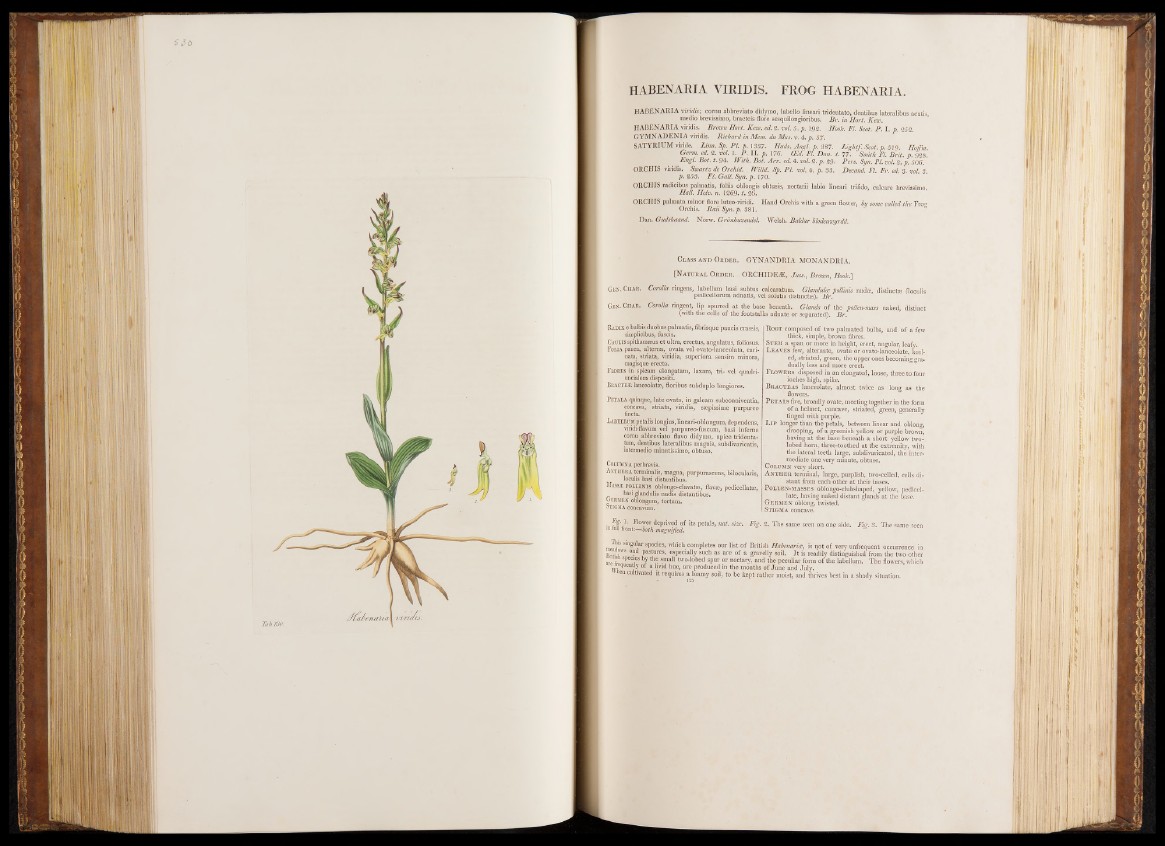
HABENARIA VIRIDIS. FROG HABENARIA.
HABENARIA v irid is; cornu abbreviato didymo, labello Iineari tridentato, dentibus lateralibus acutis
medio brevissimo, bracteis flore sesquilongioribus. B r . in H o r t. K ew .
HABENARIA viridis. B row n H o r t. K ew . ed. £. vol. 5 . p . 192. Ho o k . FI. Scot. P . I. p . 252.
GYMNADENIA viridis. R ic h a r d in M em . du M u s . v. 4. p . 5 7 .
SATYRIUM viride. L in n . Sp. P l . p . 1337. H u d s . A n g l p . 387. L ig h t / . Scot. p . 519. Ho ffm.
G e rm . ed. 2 . vol. 1. P . II. p . 176'. (E d . F l. D a n . t. 77. Sm ith Fl. B r i t . p . 928.
E n g l. B o t. t. 94. W ith . B o t. A r r . ed. 4. vol. 2. p . 29. P e r s . S yn. P l. vól. 2. p . 5 0 6 .
ORCHIS viridis. S w a r tz de Orchid. W illd . S p. P l . vol. 4. p . 33. De ca n d . Fl. F r . ed. 3. v o l 3
p . 253. F l . G a ll. S y n . p . 170.
ORCHIS radicibus palmatis, foliis oblongis obtusis, nectarii labio lineari trifido, calcare brevissimo
H a ll. H e lv . n . 126 9 . t. 26.
ORCHIS palmata minor flore luteo-viridi. Hand Orchis with a green flower, b y some called th e Fro<*
Orchis. R a i i S y n . p . 381.
Dan. Gudshaand. Norw. Grönh u ven d el. Welsh. B a ld a r blodeuwyrdd.
Class antd Ord er . GYNANDRIA MONANDRIA.
[N atural Ord e r . ORCHIDE/E, J u s s ., B raw n , Hook.]
Gen. Char. Corolla ringens, labellum basi subtus calcaratum. Glandulce po llin is nud®} distinct® (loculis
pedicellorum adnatis, vel solutis distinctis). B r .
Gen. Char. Corolla ringent, lip spurred a t the base beneath. Gla n d s o f the pollen-mass naked, distinct
(with the cells of the footstalks adnate or separated). B r .
Radix e bulbis duobus palmatis, fibrisque paucis crassis,
simplicibus, fuscis.
Caulis spithamæus et ultra, erectus, angulatus, foliosus.
Folia pauca, alterna, ovata vel ovato-Tanceolata, carinata,
striata, viridia, superiora sensim minora,
magisque erecta.
Flores in spicam elongatam, laxam, tri- vel quadri-
uncialem dispositi.
Bracteæ lanceolat®, floribus subduplo longiores.
Petala quinque, late ovata, in galeam subconniventia,
concava, striata, viridia, sæpissime purpureo
tineta.
Labellum petalis longius, lineari-oblongum, dependens,
viridi-flavum vel purpureo-fuscum, basi inferne
cornu abbreviato flavo didymo, apice tridenta-
tum, dentibus lateralibus magnis, subdivaricatis,
intermedio minutissimo, obtüso.
Columna perbrevis.
Anthera terminalis, magna, purpurascens, bilocularis,
loculis basi distantibus.
Massæ pollinis oblongo-clavat®, flav®, pedicellat®,
basi glandülis nudis distantibus.
Germen oblongum, tortum.
Stigma concavum.
Root composed of two palmated bulbs, and o f a few
thick, simple, brown fibres.
Stem a span or more in height, erect, angular, leafy.
Leaves few, alternate, ovate or ovato-lanceolate, keeled,
striated, green, the upper ones,becoming gradually
less and more erect.
Flowers disposed in an elongated, loose, three to four
inches high, spike.
Bracteas lanceolate, almost twice as long as the
flowers.
P etals five, broadly ovate, meeting together in the form
of a helmet, concave, striated, green, generally
tinged with purple.
L i p longer than the petals, between linear and oblong,
drooping, o f a greenish yellow or purple brown,
having at the base beneath a short yellow two-
' lobed horn, three-toothed at the extremity, with
the lateral teeth large, subdivaricated, the intermediate
one very minute, obtuse.
Column very short.
A n t h e r terminal, large, purplish, two-celled, cells distant
from each other a t their bases.
Pollen-masses oblongo-clubshaped, yellow, pedicellate,
having naked distant glands at the base.
G e rm en oblong, twisted.
Stigma concave.
2. The same seen on ong side. • iV ’ ^ ower deprived of its petals, n a t. size. Fig . F ig . 3. The same seen
in lull front:—both magnified.
SlnS°,,ar sPecies’ which completes our list of British H aiem rix, is not o f very unfrequent occurrence in
British"S a - Pas*;ures’ especially such as are of a gravelly soil. It is readily distinguished from the two other
a... JJ* speci1.es 7 th® small two-lobed spur or nectary, and the peculiar form of the labellum. The flowers, which
equently of a livid hue, are produced in the months of June and July.
nen cultivated it requires a loamy soil, to be kept rather moist, and thrives best in a shady situation.